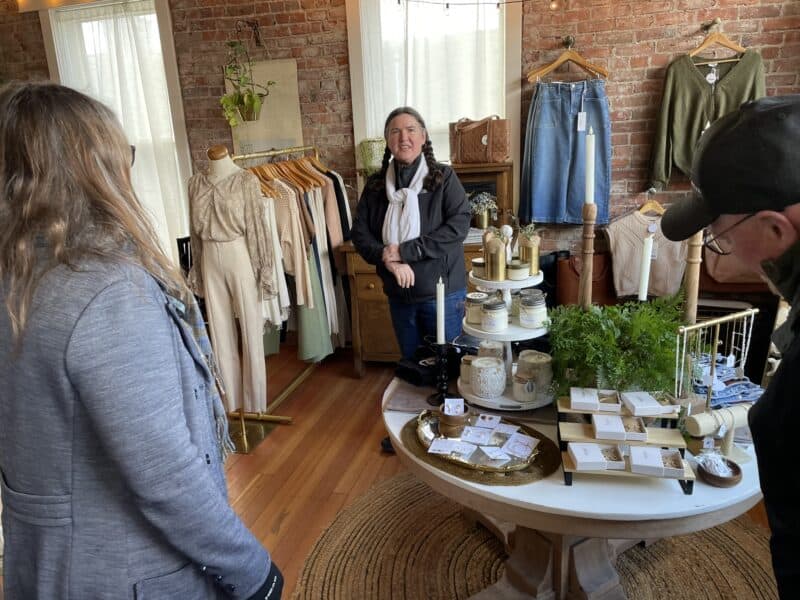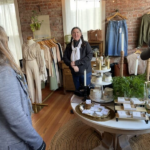TREND 2025: Retail’s Big Split: what small town retailers can do now
Remember the Retail Apocalypse around 2017? In a media interview this week, I brought up that it was actually Retail’s Big Split, not an apocalypse, and it’s ongoing. The reporter asked me to explain, so here’s my update for today’s retail landscape. “Everything gigantic in American life is about to get smaller or die.” […]
Remember the Retail Apocalypse around 2017? In a media interview this week, I brought up that it was actually Retail’s Big Split, not an apocalypse, and it’s ongoing. The reporter asked me to explain, so here’s my update for today’s retail landscape.

This combination business offers tiny spaces to retail pop-ups along with coffee and sweet treats. It offers plenty of meaningful, interesting purchases in this historic building in Potlatch, Idaho. Photo by Ana Blaisdell.
“Everything gigantic in American life is about to get smaller or die.” James Kunstler wrote in 2013. He said big box retailers were on the brink of scale implosion, and that “every element of economic reality is now poised to squash them.” It was a provocative stance for 2013, and I’ve been monitoring small retail trends at least as long.
By 2017, it seemed like we went over the brink. Every week brought another story of big retail jobs lost, the shuttering of stores, and the financial losses at big retailers.
You might think small retailers, especially small town retailers, don’t stand a chance. But that’s not true.
There are a lot of news stories that point to eCommerce as the cause of big in-person retail’s decline and also as its replacement. Today, you don’t run to the big box store for regular items like paper towels or laundry soap. You just tell your voice assistant to order it online. Even more automated, you’ve probably set up all kinds of regular items on recurring shipments that you don’t even think about. Smart refrigerators can already integrate with your voice assistant to make it easy for you to place more orders. Soon the fridge itself will notice you’re low on something and just reorder it for you. That means no chance for a big box store to capture an impulse purchase when you make a quick run to the store for those items.
It’s worth noting that online sales today only amount to 16% of all retail sales, though that has doubled since I first wrote about the Big Split in 2017. Online sales aren’t the only cause for big retail’s decline or the only replacement. We’re also purchasing less for a variety of societal and cultural reasons. See also the Buy Nothing group you belong to on Facebook, underconsumption core, and thriving interest in sustainability, secondhand and vintage shops. But that still leaves a lot of purchases being made, just not as much at big boxes and not all online.

Small town retail still brings meaning and charm to everyday purchases, like this store in Rosthern, Saskatchewan. Photo by Becky McCray.
Where are the rest of sales going? Small retailers.
While all boring retail purchases get automated, interesting retail purchases become small, sustainable, curated, handcrafted, local and integrated with technology. Items we care about, are interested in, and want to enjoy shopping for, will come from small local retailers.
Author David Sedaris summed up this consumer feeling in an interview:
“I’d rather go to an actual shop — preferably a small one — than to a harshly lit superstore, or, worse still, a website,” Sedaris said. “I don’t want to buy my books and my toilet paper and my clothing all under the same roof. I want beauty in my life. I want charm. I want contact with actual people. It is, for me, a large part of what makes life worth living.”
The MasterCard SpendingPulse for Small Business reported on the “general consumer trend to shop small” for years. IBM Research predicted local retailers’ increasing use of technology.
Smart local stores today do both digital and physical retail. The physical store is close to customers for immediate gratification. Local business owners tell us on the Survey of Rural Challenges that they add the product information and reviews of online, plus the data to be more personalized, like wishlists and recommendations. Local stores bring the product right to where the shopper can physically touch it.
Classes and hands-on activities turn shopping into a memorable experience. That’s a layer of meaning that no big box store or online order can duplicate.

The experience of visiting a converted barn, shopping dozens of local artisans, and even joining a hands-on class brings more meaning to every purchase from the Artists at the Dahmen Barn in Uniontown, Washington. Photo by Becky McCray
What can local stores in small towns do today to capitalize on retail’s big split?
-
Use big retail’s own tools against them. Try these 7 big-retail tricks including automatic orders, delivery, and better recommendations.
-
Add more technology to be more human. Use tablets to improve your service. Teach customers how to buy from you through Alexa and Siri.
-
Offer experiences and items that can’t be bought online. Locally-produced items, personalization and special services give you an advantage. In store classes, demonstrations and hands-on crafts are memorable experiences.
-
Be your best small town self. Use your 7 Strengths as a small town retailer and shore up these 7 Common Weaknesses of Local Shops.
